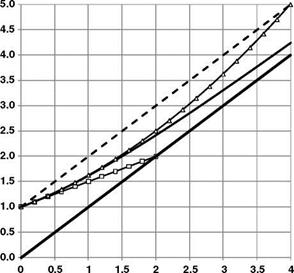Axial Flight
When the rotor leaves the hovering condition and moves in a vertical sense the flow still remains symmetrical about the thrust force line, that is normal to the rotor disc. In climb, the situation is relatively straightforward to model; however, in descent problems arise. This comment is particularly focused on the use of a momentum-based theory. The flow details become very complex in a medium descent rate condition where the descent rate is of similar magnitude to the induced velocity in hover. A quick view of this type of condition sees opposing flows at the rotor disc of similar magnitude. In order for a momentum theory to be applicable, there must be a realistic throughput of flow along the entire streamtube length. The first situation to be investigated is climb.
2.2 Momentum Theory for Vertical Climb
Consider the rotor in climb, where, again, we observe the flow from the point of view of the rotor. The flow enters the streamtube far upstream of the rotor (because of the climb velocity the streamtube has a finite cross-section), and then passes through the rotor itself, finally passing away from the rotor forming the wake. As a momentum change must be generated, and also making the assertion that the rotor is producing a thrust force in a vertically upward direction, the air will accelerate towards the rotor disc as it approaches from the upstream direction and then accelerate further as it moves downstream into the wake. In order to analyse this situation, the flow velocities are shown in Figure 2.3, the streamtube cross-sectional areas in Figure 2.4 and pressures in Figure 2.5.
The air enters the streamtube with velocity VC and then acquires an additional velocity of Vi as it passes through the rotor disc. It finally forms the wake with a velocity increase, from Vc, of V2.
The rotor thrust force, T, can be evaluated by considering the momentum increase. The continuity of the mass flow through the streamtube can be expressed thus:
Mi (Vc) = M(Vc + Vi) = M2(Vc + V2) (2.20)
The rate of change of momentum gives the rotor thrust as:
![]() T = pA(Vc + Vi)V2
T = pA(Vc + Vi)V2
Equation 2.21 represents the mass flow with the velocity increase down the entire length of the streamtube.
As discussed in the hover analysis, the thrust can also be expressed in terms of the difference of air pressure on both sides of the rotor disc – Equation 2.3. Again, the final consideration is the
|
pL + 2 p(VC + Vi)2 — Pi + 2 p(VC + V2)2 |
|
pL ^pU — 2 p(VC + V2)2 2 P(Vc)2 1 — 2 p(2Vc + V2)V2 Assembling (2.3), (2.21) and (2.24) gives: |
|
|
|
|
|
|
|
|
|
|
|
|
|
|
 |
Substituting (2.25) into (2.21) we find:
![]()
![]() T = 2PA(Vc + Vi) Vi
T = 2PA(Vc + Vi) Vi
from which we obtain:
v2 + Vc • vi-2ГА = 0
Vi2 + Vc • Vi-V2 = 0
*Y + Vc • V-1 = 0
V0 V0 V0
(we denote the induced velocity in hover for the same thrust as V0) with solution:
If the climb rate is relatively low, then (2.28) can be expanded to give:
The variation in the solution and the various approximations is shown in Figure 2.6.
The first-order solution can be used for small climb rate ratios up to 0.2, the second order can be used to a value of 1.0. Exceeding these limits will give a spurious result.
The power consumed is now given by the product of the thrust and the total velocity through the rotor disc, that is:
P = T (Vc + Vi)
= T • Vc + T • Vi
(2.30)
= P CLIMB + P i
P
T = Vc + Vi
We have the induced power as before but the climb power is now added.
Considering the last equation of (2.30), the variation of the power thrust ratio (relative to the hover value) is shown in Figure 2.7.
![]()
|
|
|
|
|
|
|
|
|


The full solution and the two approximations are shown. In addition, the variation of the climb-only power ratio and the total power ratio – assuming no change in the induced velocity – are also shown. The limitations of the approximations are as before; however, the climb-only and constant induced-velocity lines bracket the full solution. As the rotor begins to climb, the mass flow entering the rotor increases and with a constant thrust the momentum generation can be achieved with a lower induced velocity – hence the reduction in the induced power. This means that the power to climb steadily is eased by this reduction in induced velocity. In the limit, when the climb rate becomes extremely large, the induced velocity asymptotes to zero.
 |
||
In non-dimensional terms these results become:












